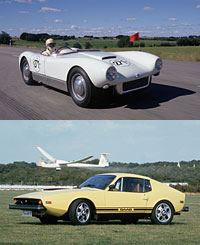|
|
||||
|
Saab Sonett Celebrates 50 Years
|
|||

The Saab Sonett sports car was originally named after the Swedish expression “så nätt”, meaning “so neat”. Now, half a century after the launch of the first generation, the Sonett is known the world over as Saab’s quintessential two-seat sport car. On Sunday, 15th October, Saab enthusiasts will be gathering on the Swedish Car Day at the Larz Anderson Museum in Brookline, Massachusetts, USA to celebrate the brand and 50 years of Saab Sonett in particular. Among the participating cars will be several key members of the Saab Automobile USA heritage collection, including Sonetts of each generation: a priceless, dark orange 1956 Sonett I, a silver 1967 Sonett II 2-stroke and a recently acquired blue 1970 Sonett III V4. The Saab Sonett I “Super Sport” was first unveiled at the 1956 Stockholm Motor Show and made its North American debut later that year in New York. Originally designed to compete in a racing series that eventually never materialised, Saab only built 6 first-generation Sonetts - which all remain in existence today. Using contemporary Saab aircraft practices, the Sonett chassis was formed by a riveted aluminium box carrying a fibreglass roadster body. Utilising the “high-performance” (57.5 bhp) version of the 3-cylinder 750 cc 2-stroke engine found in the Saab model 93, the drivetrain was “reversed” so that the engine is behind the transmission and front wheel drive is retained. The 2-stroke engine rotates in the opposite direction from the production Saab sedans of the era to accommodate this reverse transmission layout. Starting in 1967, the Sonett II represented Saab’s second and much more ambitious foray into the world of two-seat sport cars. Aimed primarily at the North American market, the sporting intentions of this agile coupe were obvious since the race winning Model 96 Monte Carlo 2-stroke engine, fitted with three-carburetors, was specified as standard equipment. The fibreglass body was attached to a sheet steel frame featuring an integrated roll bar. An unusual one-piece front end hinged completely out of the way for easy access to the engine, transmission and front suspension components. Only 258 Sonett II’s with the Monte Carlo spec engine were built during the two years of production. A subsequent, more powerful, V-4, four-stroke version of the Sonett II, distinguished by a bulge on the bonnet to accommodate the taller engine, brought more horsepower, more speed and a total of 1,868 cars built over the next three years. Launched at the 1970 New York Motor Show, the third generation Saab Sonett was a significantly different car from its predecessor. The V-4 engine was tuned for more horsepower to compensate for the increases in size and weight in the new car. In terms of styling, the Sonett III benefited from contributions by the Italian designer Sergio Coggiola, featuring bolder front and rear sections plus a new interior. In the back, the Sonett III gained a hinged rear window, offering easy access to the rear luggage compartment. In front, the new treatment included manually-operated pop-up headlights. In addition, features like air conditioning and a floor-mounted transmission shifter were added to meet the requests of U.S. dealers and buyers. The year 1974 turned out to be the last model year for the Saab Sonett, bringing the production total to 10,236 cars since inception. The very last Sonett to leave the factory in Arlöv, Sweden was bright yellow. It currently resides in the Saab Automobile factory museum in Trollhättan near Gothenburg, on the Swedish West Coast. | ||||

